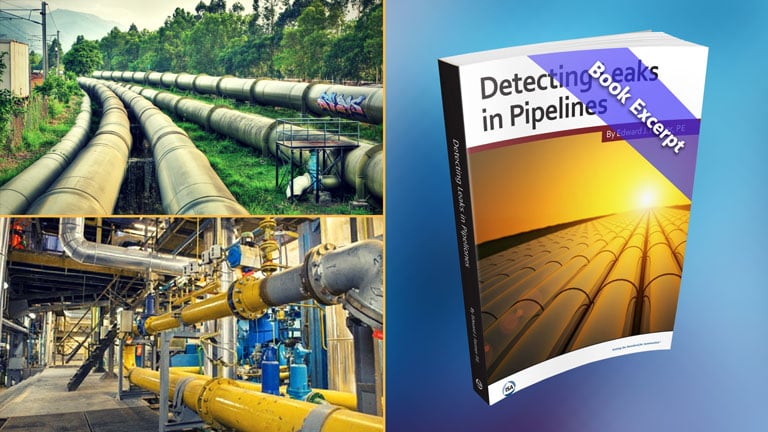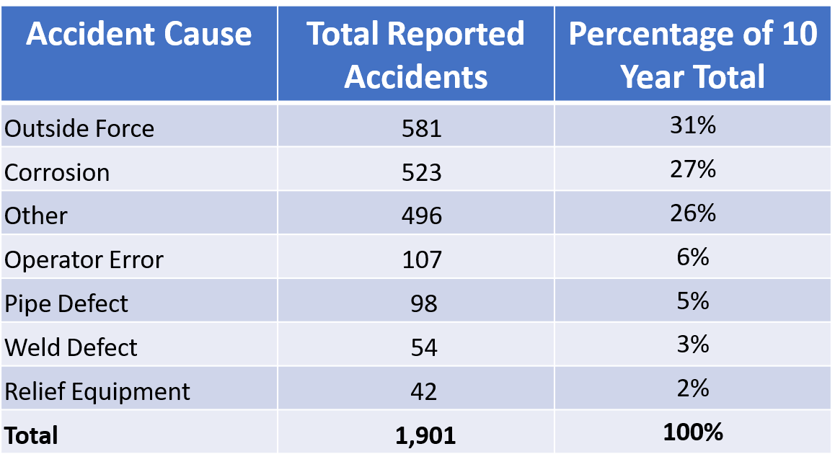This guest blog post is part of a series written by Edward J. Farmer, PE, author of the new ISA book Detecting Leaks in Pipelines. To read all the posts in this series, scroll to the bottom of this post for the link archive.
When designing safety and protection systems, it is always useful to understand the nature of the threat. To that end, the U.S. Department of Transportation (DOT) has accumulated data and statistics regarding leaks on regulated pipelines. Some years ago, my company, EFA Technologies, used DOT data to explore the causes of pipeline leaks over a 10-year period. The results of that work were published and are included in Detecting Leaks in Pipelines as Appendix I.

The DOT categorized reported leaks into six specific categories plus one labeled "Other." Over the 10-year study period there were 1,901 leaks that required reporting for one reason or another. This chart shows the causes distributed across the classification categories:

The “Other” category includes just over a quarter of the accidents, indicated to be the result of vandalism, gasket failure, “bullet hit the pipe” and a diversity of even more obscure issues which serve to remind us that it is hard to foresee and plan for everything. Appendix I in the book includes a lot more detail than we can explore here. The inescapable conclusion is that while many leaks can be prevented by planning, design, construction, maintenance, and management there are many that cannot. Damage by others, for example, was the cause of nearly three-fourths of the “Outside Force” accidents. In a subsequent paper (also in Detecting Leaks in Pipelines), I explored the higher accident frequency at “crossings,” places where a pipeline crosses some other right-of-way such as a railroad, highway, or utility easement.
When designing safety and protection systems, it is always useful to understand the nature of the threat. To that end, the U.S. Department of Transportation (DOT) has accumulated data and statistics regarding leaks on regulated pipelines. Some years ago, my company, EFA Technologies, used DOT data to explore the causes of pipeline leaks over a 10-year period. The results of that work were published and are included in Detecting Leaks in Pipelines as Appendix I.

Clearly, some of the categories can be mitigated by the operator companies. A lot of thought, for example, goes into specifying the metallurgy of line pipe and the anti-corrosion measures that are appropriate on both the inside and the outside. Pipelines, though, often move past their initial purpose and past their design life. Changing the use of a pipeline, or the fluid in it, or the rate-of-flow, or even features of the installation environment, may suggest different design criteria than what were originally appropriate, perhaps even optimal.
Cost of leaks
The accident statistics investigation also explored the cost of leaks. As one would expect, nearly any leak results in costs in the tens of millions of dollars, and seems to be increasing over time. About a third of the documented costs involve property damage and cleanup. The rest go to fines, legal costs, and other legally mandated assessments. During this period the president of a major pipeline operator observed that while the costs associated with any accident are significant, the loss of good will by those who will not forget what happened is beyond calculation. Another industry icon, Constantine Nicandros, then president of CONOCO Inc, observed, “Every company in this business may be judged by the performance of the worst among us.” He went on to say that, “We can be sure that if we do not police ourselves, others will be more than happy to take up the task. I believe that in the days ahead our industry will thrive if we do a better job of listening to the public and earning their trust.”
These observations by these industry leaders help answer the question, how important is pipeline safety? They also suggest an analysis of what is required by mandate or regulation may be a subset of what is truly necessary or desirable.
These are old data but were stable during the study period and a couple of decades around them. Only the accident cost showed an upward trend. Appendix I shows a lot more detail.
Theft remains a concern
When this study was done, theft was involved in only a small number of operations. In the U.S., that’s probably still true. In many parts of the world, though, theft is a significant safety and financial hazard. If one were to revisit this study it would be very interesting to assess the impact, if any, of the increase in theft that we see in some parts of the world.
This study is a good place to start evaluation of the risks confronted by any pipeline operation. It provides a good list of threat causes and an assessment of the significance of each of them. While things change over time, and while they vary in each situation, these are factors that should be considered, but as time moves along, perhaps not all the factors that could be involved. Fortunately, there are processes for analyzing risk and some features of those will be discussed in a future blog post.
How to Optimize Pipeline Leak Detection: Focus on Design, Equipment and Insightful Operating Practices
What You Can Learn About Pipeline Leaks From Government Statistics
Is Theft the New Frontier for Process Control Equipment?
What Is the Impact of Theft, Accidents, and Natural Losses From Pipelines?
Can Risk Analysis Really Be Reduced to a Simple Procedure?
Do Government Pipeline Regulations Improve Safety?
What Are the Performance Measures for Pipeline Leak Detection?
What Observations Improve Specificity in Pipeline Leak Detection?
Three Decades of Life with Pipeline Leak Detection
How to Test and Validate a Pipeline Leak Detection System
Does Instrument Placement Matter in Dynamic Process Control?
Condition-Dependent Conundrum: How to Obtain Accurate Measurement in the Process Industries
Are Pipeline Leaks Deterministic or Stochastic?
How Differing Conditions Impact the Validity of Industrial Pipeline Monitoring and Leak Detection Assumptions
How Does Heat Transfer Affect Operation of Your Natural Gas or Crude Oil Pipeline?
Why You Must Factor Maintenance Into the Cost of Any Industrial System
Raw Beginnings: The Evolution of Offshore Oil Industry Pipeline Safety
How Long Does It Take to Detect a Leak on an Oil or Gas Pipeline?
Book Excerpt + Author Q&A: Detecting Leaks in Pipelines
About the Author
Edward Farmer has more than 40 years of experience in the “high tech” part of the oil industry. He originally graduated with a bachelor of science degree in electrical engineering from California State University, Chico, where he also completed the master’s program in physical science. Over the years, Edward has designed SCADA hardware and software, practiced and written extensively about process control technology, and has worked extensively in pipeline leak detection. He is the inventor of the Pressure Point Analysis® leak detection system as well as the Locator® high-accuracy, low-bandwidth leak location system. He is a Registered Professional Engineer in five states and has worked on a broad scope of projects worldwide. His work has produced three books, numerous articles, and four patents. Edward has also worked extensively in military communications where he has authored many papers for military publications and participated in the development and evaluation of two radio antennas currently in U.S. inventory. He is a graduate of the U.S. Marine Corps Command and Staff College. He is the owner and president of EFA Technologies, Inc., manufacturer of the LeakNet family of pipeline leak detection products.




